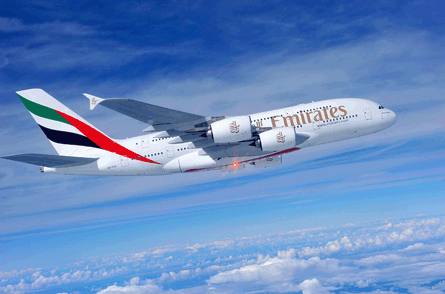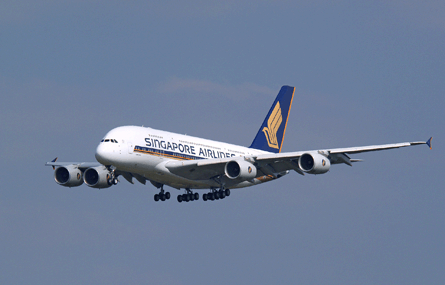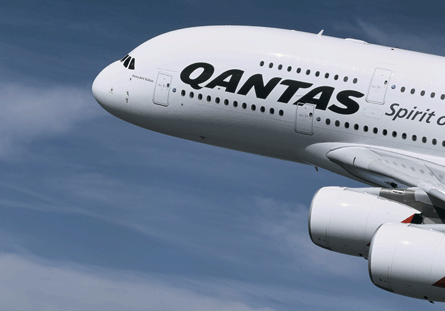When the Airbus A380 finally entered service with Singapore Airlines in October 2007, the ultra-large aircraft ushered in a new era for the world's airlines. Two years since that debut, the 20 A380s in service with three airlines - SIA, Emirates and Qantas - have operated 8,000 flights and carried at least 2.5 million passengers. And Air France has just become the latest to join the throng.
Airline Business has spoken to all three early operators and they agree the A380 has delivered on its promise, heralding a revolution in passenger enjoyment and operating cost performance. But it also suffers niggling problems that have taken the shine off an otherwise outstanding entry into service.
"Despite a teeth-pulling two years through all the delays, this aeroplane is a peach," says Emirates Airline president Tim Clark. "Once you've flown on it you will not want to go [any other way] if you have a choice - which will make them feel very ill in Seattle."
|
|---|
All the operators echo Clark's view that the A380 has proved massively popular with passengers, demonstrated by the type's consistently high load factors. Clark puts the "A380 effect" on seat factors at "five to seven percentage points, maybe more". Emirates' A380 load factors are averaging 90-100%. "It's extraordinary," says Clark. "If people can fly the A380 they will. And it hasn't cannibalised our other services, except perhaps on Gatwick business [class loads]. I think there has been a shift from Gatwick if they know there's an A380 on [Heathrow]," says the Emirates chief.
Pulling Power
SIA says its A380 load factors "remain above the system-wide average", but it declines togive figures by aircraft type for commercial reasons. "Suffice to say A380 flights remain very popular and on routes where we have multiple daily frequencies with different aircraft types, the A380 services tend to be the most in demand," it says.
The operators put the A380's passenger appeal down to a combination of quiet and spacious cabins, a high standard of in-flight entertainment and the giant's comfortable ride. "She goes through turbulence like a huge Queen Mary 2 on the North Atlantic in January," says Clark. "There's so much space in the aircraft. It's only 10-abreast, same as the 747, but it is wider - wider aisles, wider seats. Economy passengers can walk around. There's a great feel-good factor."
|
|---|
Emirates does not charge a premium for the A380, although it does avoid discounting the type, compared with other aircraft in its fleet. "The A380 is our pricing marker - it is held," says Clark. Fellow operator SIA says "there is no premium on the A380", aside from its Suites class, which is exclusive to the type and is priced differently from First Class on its other long-haul aircraft.
But Clark says the downside of having such a popular and large aircraft is "lose one, and you're in trouble". He continues: "One way or another, generally we can disperse our passengers through our other flights and by using other carriers." But the pulling power of the A380 is extremely strong. Clark says on one occasion where an A380 had technical problems "about 70% of the passengers refused to go [by another means], they wanted to night-stop and wait for the A380 to work".
While Emirates was not the first to receive the aircraft, it is the biggest customer with an order for 58 of the type. It received its first 489-seater in July 2008 after, like fellow customers, suffering a series of reschedules which pushed back its original delivery date by more than two years. It now has five in service and is due to take 10 more by the summer of next year. "After that we have dates that remain fluid," says Clark.
Nine months before the first Emirates delivery, it was SIA that led the way as launch operator. SIA took its first A380 on 15 October 2007, kicking off the arrival of its 19-strong order. It put the type into revenue service 10 days later between Singapore and Sydney. SIA had been due to receive its first 471-seat A380 in the second quarter of 2006, but a six-month certification delay was compounded by production woes which pushed first delivery back by a further 10 months.
"The first three months went almost flawlessly," says the airline's senior vice-president flight operations Capt Gerard Yeap. "We were breaking new ground everywhere. It was something everyone in SIA felt so proud of."
|
|---|
In fact, Sirisena says the 10-month delay between certification and the arrival of the first aircraft gave everyone involved some breathing space. "When the aircraft was delayed we took the opportunity to work with Airbus and the manufacturers to see what we could fix before service entry. What we couldn't fix we made sure we understood and were prepared for," he says.
Breathing Space
When the aircraft did arrive, SIA's marketing took a sympathetic approach to scheduling to ensure it met its daily commitment, allowing a six-hour window in Singapore between rotations. Sirisena says: "They made a bit of a sacrifice by choosing a sub-optimal widow for the return leg from Sydney to give us enough time when the aircraft arrived in Singapore to fix defects and prep it for the next service."
Qantas, meanwhile, took its first A380 in September 2008 and now operates five in a 450-seat layout. Qantas executive general manager, operations Lyell Strambi describes its experience as "exceptional, from both operational and customer perspectives. Expectations have been more than met".
For Airbus it was crucial that when the revolutionary aircraft made the headlines during its debut - as it inevitably would - it was not for the wrong reasons. After the programme suffered lengthy production delays that resulted in the assembly process having to be reinvented, there were sceptics waiting to see if the double-decker would fall on its face when it began earning money.
|
|---|
None of the operators have any issues with manufacturer support. Indeed, Clark - who is a particularly hands-on airline boss from a technical operations perspective - says Airbus has "an army of people in Dubai, supporting us" and that he speaks "directly" to Airbus chief Tom Enders about issues. Sirisena points out that with the A380 being a "showcase, there has always been a very strong support presence from Airbus, although it has been scaled back from the 'meet-and-greet' level when it first went into service".
John Vincent, who was Qantas's acting executive manager engineering at the time of the interview, also agrees. "Airbus has provided, and continues to provide, a high level of support at all destination ports across our A380 network. Airbus specialists are on hand for all arrivals and departures and there is a substantial presence in Sydney, where the maintenance operation is based," he says.
|
|---|
Over at Emirates, Clark says the A380 fleet is undergoing "a big mod programme" which requires removing an aircraft from service. This should be completed on the five aircraft already in service by February, he explains, while the new arrivals will have the latest modification as standard. The industry's typical technical dispatch reliability benchmark is above 98.5%, and Clark says that, while Airbus is guaranteeing 98.5%, "we're not there yet. We're at 97%, sometimes 96%".
Nuisance Warnings
The major problem being experienced is the plethora of system nuisance warnings, which are "driving down technical dispatch", he says. "Airbus is very, very anxious to get the issues sorted out." Emirates and SIA both perceive the A380's warning system as being too sensitive, resulting in misplaced fault messages about systems or equipment. "They didn't build enough tolerances into the software, they've made it over complex," says Clark. We have false alarms but we're not prepared to dispatch until they're sorted out."
Sirisena adds: "What we are grappling with are algorithms for failure detection, which not only detect a failure but also act upon it. Unfortunately this can lead to a perfectly healthy system being shut downor [a no-go fault warning] for a problem that was minor enough to have been deferred. Once we identify a problem and understand it, Airbus will quickly come up with a work-around. But it is not so straightforward to re-programme."
Clark says that the problem with the nuisance warnings has been their diverse nature, but "the common thread" is the software. He says Airbus executive vice-president for programmes Tom Williams and his team "have sat in my office many times and said they can't identify trends, which is the worst possible thing". The Emirates chief blames the software's design. "There was a philosophy of utopia - I suspect that Airbus was blessed with some boffins who said 'we've got to make this absolutely perfect - no flexibility'. The slightest surge causes one [sensor] to trip and then six more as they're all linked. I've told Airbus we need an audit of the software on this aeroplane, and I've asked them how they're going to address it." Airbus has undertaken to raise Emirates' dispatch reliability to the 98.5% target by January, but Clark is sceptical: "They've got some work to do."
Qantas is less specific about the problems it has suffered. Vincent says the airline "did encounter some issues" around fuel tank indication and nose wheel steering, but it "worked closely with Airbus at the time and these were resolved quickly". Strambi says dispatch reliability has been "good" and the airline has generally "been happy" with reliability, considering this is the first 12 months of operating a brand-new fleet type.
A happier tale is the A380's performance, which has bettered expectations. "Meeting the performance guarantees doesn't come into it, she's ahead of her nominals," says Clark. "The faster the A380 flies the less fuel it burns." Qantas' Strambi concurs: "The A380 has met or exceeded all the original performance, noise and fuel burn guarantees made by Airbus at the time the aircraft purchase decision was made."
SIA's flight operations chief Capt Yeap says the airline's pilots have "transitioned easily" to the aircraft's size as many were already familiar with 747-400. "Crews are very happy after their first circuit. The A380 is a well-designed aeroplane. It is responsive for its size and accurate to fly," Yeap says.
The three A380 operators deploy their fleet across the globe, serving destinations in North America, Australasia, the Pacific Rim and Asia. All three fly between London and Sydney - with Qantas shadowing SIA's routing via Singapore, while Emirates flies through its Dubai hub. All the airports that the type serves have been well prepared for the aircraft. "With air bridges to main and upper deck passenger enplaning and deplaning is poetry in motion," says Clark. He adds that as Emirates' A380 fleet grows next year, new destinations are likely to include Paris and Seoul and he wants to return to New York - where it inaugurated its A380 operations in 2008 - by June. Tokyo Narita is also a potential future destination.
But while there are planned dates for new A380 routes, Clark concedes that these are contingent on Airbus meeting the delivery schedule. "We still have some niggling delays from Toulouse - they're still not stable on the production side." He meets Airbus chief executive Tom Enders and programmes boss Tom Williams regularly to discuss the delivery schedule, but remains concerned about Airbus' ability to maintain the delivery stream to incumbent customers as operators such as Air France and Lufthansa take their first A380s.
Shower power
The Emirates aircraftare notable for the fact that they are equipped with a pair of in-flight showers for first-class passengers, which have proved very popular, says Clark, although he concedes he "got the maths wrong" on the amount of water to uplift. "We're only using 60% - even with every first-class passenger taking a shower," he says.
Because of weight growth during development, initial production A380s are behind target. But Airbus is incorporating weight savings into later-build A380s and Clark expects these efforts will ultimately create an aircraft which can serve certain US West Coast destinations direct from Dubai. He forecasts that A380s delivered by 2012 will be "a minimum of 2t lighter", which, combined with the airline's own weight reductions, will mean "an aircraft that can fly 15h 45min and can do the West Coast". He is "optimistic" that this will bring San Francisco into range, but concedes the A380 will always be challenged to get as far as Los Angeles. "She was never designed for that mission," he says.
Clark sums up the A380's appeal in raw statistics. "We're busting the seams on the aircraft. We're consistently getting 90-100% load factors - its popularity hasn't dissipated in a year. And if Dubai International Airport grows to where we want it, we'll ultimately have more than 58 in our fleet."
Click here for A380 seating plans, video interviews and further technical information
Source: Airline Business


























